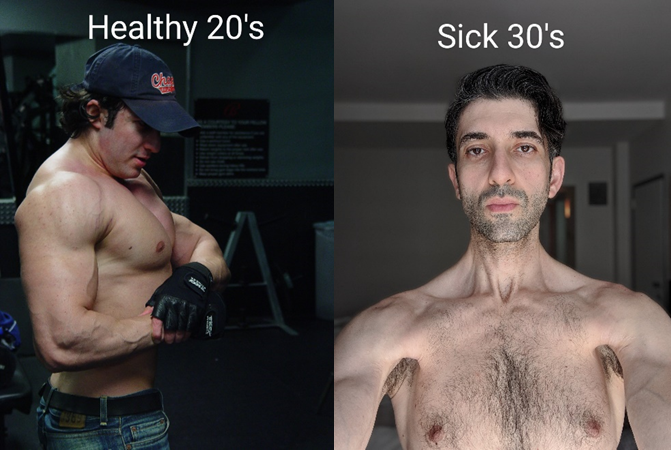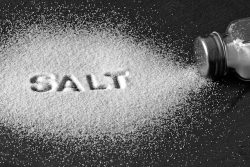Debilitating Pain
I was very physically active during my late teen and young adult years. I participated in sports and worked out heavily. At my heaviest, I was about 200lbs and very muscular. Around the age of 23-24, I began experiencing shoulder and neck muscle pain that would lead to severe headaches. By the time I was 29, the pain had become so debilitating that I had to stop working out completely. I visited numerous doctors, including neurologists, who conducted every possible test: bloodwork, x-rays, MRIs, and prescribed muscle relaxers, injections, and painkillers. I also tried physical therapy, chiropractors, and acupuncturists. At age 30, one neurologist diagnosed me with myofascial pain syndrome, a condition that doesn’t have a cure but is managed with anti-inflammatories and injections into the trigger points where the pain originates. Simultaneously, I consulted several naturopaths who recommended various supplements and diets, such as the blood type diet, food elimination diet, fasting, and intermittent fasting.

In 2013, when I was about 31, I discovered Facebook groups. Initially, the groups I joined were supposed groups and pain management groups. These groups didn’t address the root problems. A few years later, I stumbled upon biohacking groups. Unlike the previous groups, these individuals were not merely complaining about their ailments; they were actively seeking solutions. I began immersing myself in these communities, seeking better answers, and connecting with people who had similar symptoms and were experimenting with different solutions. This is where I first learned about a peptide called BPC-157. Peptides are naturally produced in the body, and by supplementing with peptides, it is believed that we are enhancing what our body already produces to improve their intended functions.
Prolonged Mold Exposure
By age 34, in addition to severe pain, I developed chronic fatigue. I had prolonged exposure to mold, but at the time didn’t know mold could be a killer. I tried many different treatments and went through many different doctors. Until I met the right doctor. She explained to me what mitochondrial dysfunction was and ran a few different tests that other doctors didn’t consider. I had heavy metal poisoning and mold toxicity. She suggested removing all my amalgam fillings and replacing them with non-mercury fillings. This doctor also recommended sweating to eliminate toxins from my body. During this period, I discovered that prolonged mold exposure from a home I was selling as a real estate agent contributed to my chronic fatigue. Due to all these symptoms, fatigue, and chronic pain, combined with an inability to eat and exercise properly, I lost 75lbs, which was mostly muscle, dropping from 200lbs to 125 lbs.
Sweating the Toxins and Repairing My Mitochondria With Peptides
After following the instruction of my doctor to sweat. Instead of going to a sauna I would sit in my hot car with the windows closed and sweat (it was summer time ). I felt ashamed to go to a sauna because I was so skinny. Little by little, I began to feel better. At the same time, I was taking BPC 157 orally, and to help improve my gut function. I had severe food sensitivities, which BPC 157 drastically reduced. This then seemed to reduce my muscle pain. Soon after, I started taking BPC 157 through injection as well. Injecting BPC-157 helped reduce muscle inflammation, further alleviating muscle pain. I also used TB-500 to reduce muscle inflammation, which also eased my pain. MOTS-C boosted my energy levels, and Thymosin Alpha 1 improved my immune system. Additionally, I used Ipamorelin/CJC-295, growth hormone secretagogues that helped me gain lean muscle.

I learned about dosages and frequencies through various biohacking and peptide groups, supplemented by research papers and medical journals from PubMed, National Institutes of Health (NIH), and the National Center for Biotechnology Information (NCBI). As of 2024, I am 90% recovered and can lead a normal life!
Because of the instrumental role that peptides played in my recovery, and the lack of formal medical guidance available from knowledgeable doctors, my friend Jacob and I decided to start this Facebook group. Jacob, who had various health issues, and I met in one of the biohacking groups. His educational background and personal experience make us a great team. Together, we created a Facebook group called “Biohacking Central” to discuss research and approaches to using peptides effectively.
We Need Your Help
More people than ever are reading Hormones Matter, a testament to the need for independent voices in health and medicine. We are not funded and accept limited advertising. Unlike many health sites, we don’t force you to purchase a subscription. We believe health information should be open to all. If you read Hormones Matter and like it, please help support it. Contribute now.
Yes, I would like to support Hormones Matter.
Feature photo by vishu on Unsplash.











